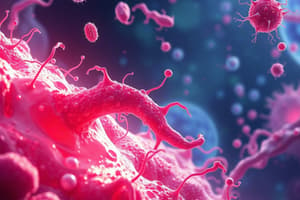Podcast
Questions and Answers
Which branch of biology studies the morphology, ecology, genetics, and biochemistry of bacteria?
Which branch of biology studies the morphology, ecology, genetics, and biochemistry of bacteria?
- Protozoology
- Virology
- Mycology
- Bacteriology (correct)
What does bacteriology involve?
What does bacteriology involve?
- Identifying and classifying bacterial species (correct)
- Researching fungi
- Studying viruses
- Analyzing protozoa
What led to advances in pathogenic bacteriology?
What led to advances in pathogenic bacteriology?
- The study of viruses
- The identification and characterizing of bacteria associated with diseases (correct)
- The study of fungi
- The study of protozoa
What is the historical relationship between bacteriology and microbiology?
What is the historical relationship between bacteriology and microbiology?
What did physicians in the 19th century need to apply the germ theory to?
What did physicians in the 19th century need to apply the germ theory to?
Flashcards
Bacteriology
Bacteriology
The branch of biology that studies the morphology, ecology, genetics, and biochemistry of bacteria.
Bacterial Identification
Bacterial Identification
The process of differentiating bacteria based on traits.
Pathogenic Bacteriology Advances
Pathogenic Bacteriology Advances
Identifying and characterizing bacteria associated with diseases.
Bacteriology vs. Microbiology
Bacteriology vs. Microbiology
Signup and view all the flashcards
Germ Theory Application
Germ Theory Application
Signup and view all the flashcards
Study Notes
Bacteriology Overview
- Bacteriology is the branch of biology focused on the study of bacteria, encompassing their morphology, ecology, genetics, and biochemistry.
Involvement in Bacteriology
- Bacteriology involves understanding bacterial structure, life processes, and how bacteria interact with their environments and hosts.
Advances in Pathogenic Bacteriology
- The development of early microbiological techniques and technologies contributed to significant advancements in pathogenic bacteriology, enhancing the understanding of disease-causing bacteria.
Relationship with Microbiology
- Historically, bacteriology is considered a subset of microbiology, which encompasses broader studies of microorganisms, including viruses, fungi, and protozoa.
Germ Theory Application in 19th Century
- Physicians in the 19th century needed to apply germ theory principles to diagnose and treat infectious diseases effectively, emphasizing the link between specific bacteria and specific diseases.
Studying That Suits You
Use AI to generate personalized quizzes and flashcards to suit your learning preferences.




